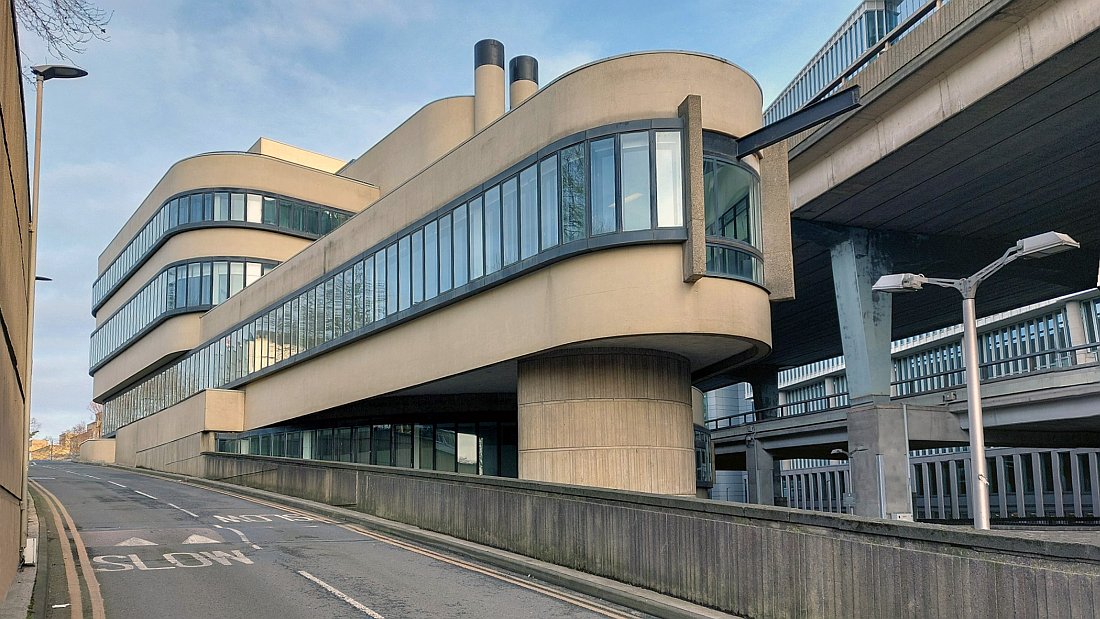A famed British Rail ship that’s for sale? Erm, which one was this then? Well it was one that stood right by water but it was also one that never floated! The last ‘captain’ of the said ‘ship’ had been one who owned a world-wide business concern that included a privatised yet highly reputable railway operator as part of its portfolio. And that was Richard Branson’s Virgin Company! The ‘ship’ or building involved rather was more to do with the music side of the business and the location proved ideal for our business magnate. And that was because the building maintained a historical connection to the very earliest days of Virgin – originally begun at a flat in London’s Notting Hill and later managed from a canal barge afloat in adjacent Little Venice. The Battleship building was originally known as the Canal House – such a name needs no explanation of any sort especially in view of the locality. However Battleship Building has been its preferred name for many years – especially in view of the campaign to prevent its demolition and highlight the fact the building does indeed represent a ship. In 2022 Virgin dis-embarked the Battleship building – thus it has been empty ever since and the freehold has been up for grabs since May 2024.

Interested in the Battleship? Time to call all hands to deck and contact the agents! Sign as viewed from the Westway. Google Streets.
British Rail’s famous Battleship building can be found at Paddington on a site that has long been the location for intensive railway and canal activity – and this is because the area has always been seen as an important focus in terms of transport. The canal arrived at Paddington in 1801, and then London’s very first bus services had begun from Paddington in 1829. Not only that the world’s first ever underground railway too began its services from Paddington in January 1863. The canal runs right by the location and indeed from the Battleship’s windows London’s famed Little Venice can be seen. Despite the close proximity of the area’s canals and the many boats that can be seen, the Battleship building is often alluded to as a landlocked ship, or as the book Savage Messiah (2019) says, its ‘something like an art deco cruiseliner…’
The Battleship building was indeed one of the main offices for Rail Freight. At some later date the premises were also used by National Carriers Limited. Monsoon too had once occupied the Battleship but they eventually moved to the Yellow Building near Westfield/White City. Monsoon however kept residency for a while longer at the Rotunda before Nissan UK moved in. The Rotunda is the other part of British Rail’s 1968 modernist development for the Paddington goods yard area. Both buildings became Grade II listed in 1994.
The Battleship Building is actually two separate buildings which consist of offices and a vehicle maintenance depot. Hence the Battleship is the offices and the vehicle depot the Rotunda.
It was built as a British Rail Maintenance Depot in 1969 and known as Canal House. A history of the building compiled by one of its present occupants (BDSP Partnership) says that, “Commissioned by British Rail it was something of a minor sensation at the time of its completion and widely touted as the first London building to come to terms with the symbolisation of a modern transport building, set as it is in the crutch of a minor motorway and the main railway station system going into Paddington Station. The administration block towered above the roadway, small in area but immensely powerful in profile.” (Alamy).
The early 2000s renovation from a British Rail repair depot into a new workspace has combined the past, present and future in order to continue the building’s original loose-fit concept. A three-story slate-floored atrium has been created and a mezzanine floor added. The ship funnels and the external Japanese mosaic decorated walls have been restored. New large double glazed windows have also been added all around the building and these keep the building’s original look. The £10 million renovation work was successful in keeping the original 1960s design by architects Bicknell and Hamilton largely intact.
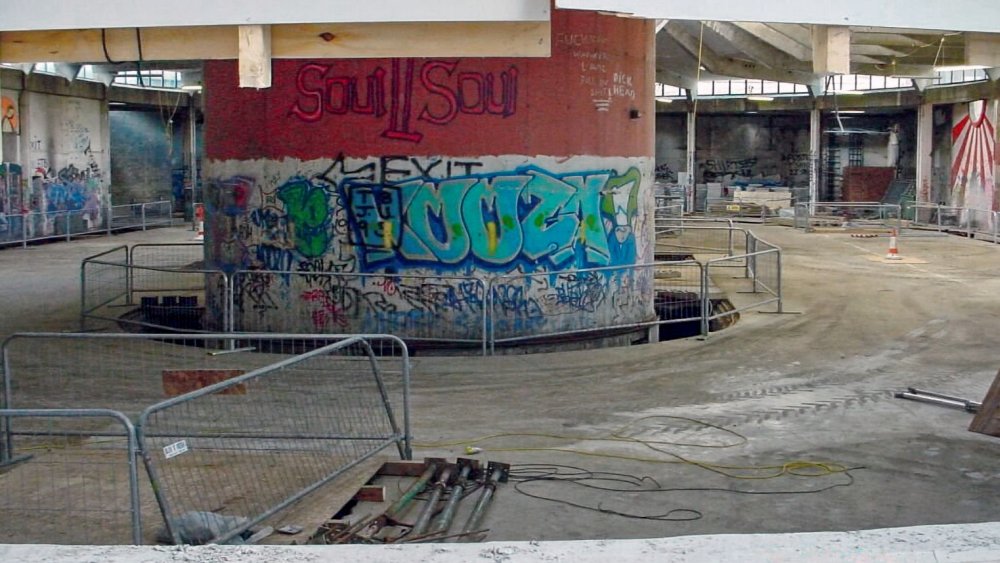
The Rotunda as an empty shell, seen in October 2001. This was once where British Rail’s fleet of freight lorries were maintained. Photo by the author.
In terms of the Rotunda, that has been a more simpler affair. The internals of the building was stripped away completely and an entire shell was made with which a complete new design could be built internally. Monsoon were the first occupants however Nissan UK later took over the Rotunda and are still resident there. Meanwhile the main premises, the Battleship building itself, remains empty and the freehold has been up for grabs since May 2024. And finding a buyer seems slow. It could be because the site is now quite overshadowed by the new Paddington development. The Westway was bad enough for the area but now the entire prospect to the south has been compromised and not a lot of light reaches the Battleship building.
On the other hand the question of finding a buyer could be because the signage advertising the freehold sale happens to be the two solitary examples that can be seen from the Westway? Maybe its envisaged some rich magnate in their Rolls Royce passing the building would see the signs and be wanting to take a good look at the premises. I don’t think that will work because one needs to see the building in its entirely from the outset – and preferably from a perspective that presents its best elements. From what can be found of the building’s sale, not a lot of advertising has been procured. If the estate agents are looking for a particular client well there’s no doubt those efforts are not working very well.
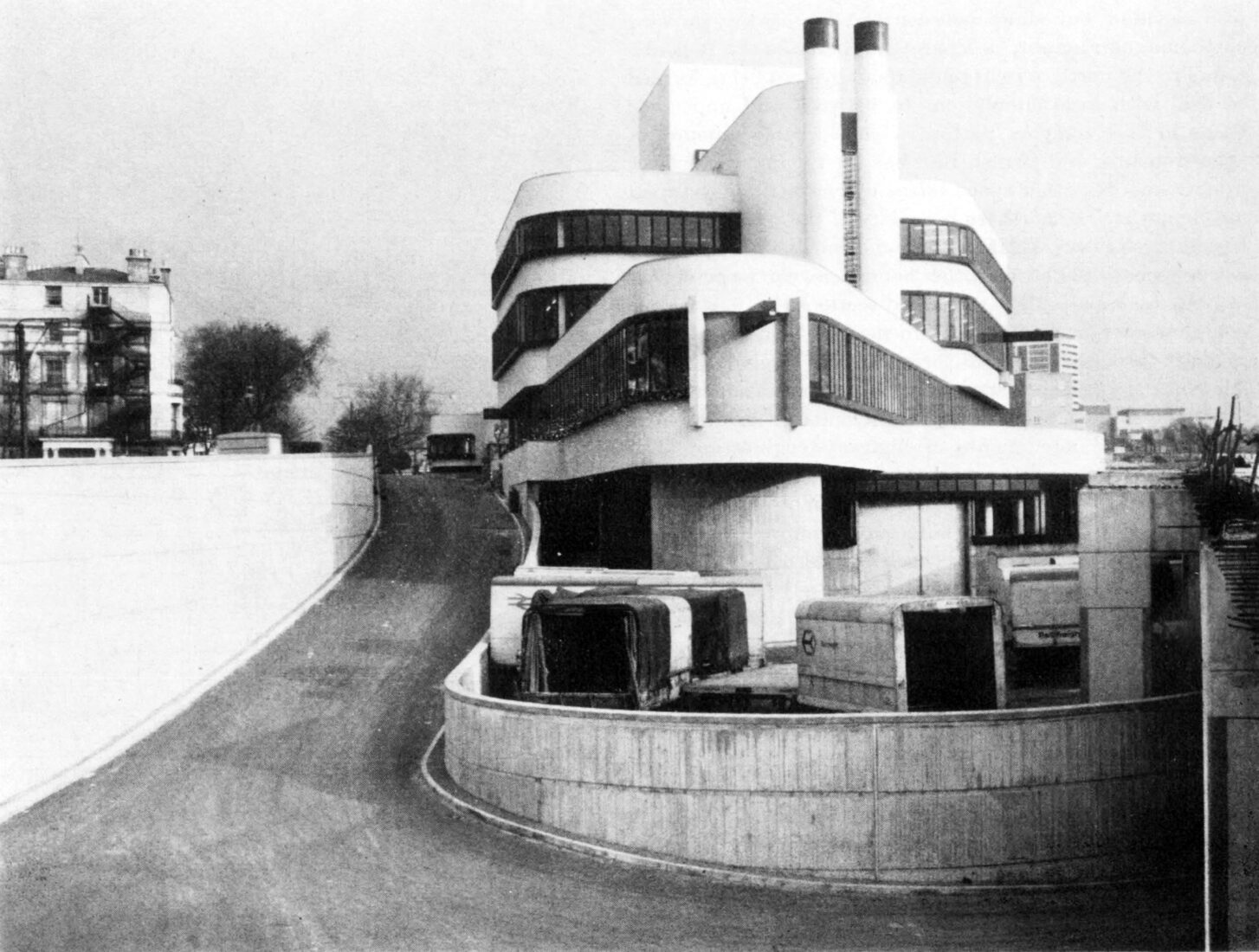
The Battleship building before the Westway (the A40) was built around it. Note the Rail Freight lorries and the long vanished gatehouse. Architect’s Journal.
Both the Battleship and Rotunda were unique designs from the acclaimed architectural firm Bicknell & Hamilton who had done other modernist work for British Railways – including Birmingham’s brutalist New Street Power Box. The Battleship building is a remarkable structure and it not only symbolizes a pivotal moment in British railway history but also showcases the aspirations of modernist architecture. Being listed means the buildings can’t be altered with ease and the unusual design which won a number of awards makes things all the more difficult. There’s no doubt it would take someone with a dedicated focus on history, railways, radical architecture and modernist aspirations to even consider the premises.
The Paddington offices were originally designed with the practical needs of railway workers in mind. The buildings were laid out in a way that maximized natural light and ventilation, creating a comfortable working environment for employees. Additionally, the offices were equipped with state-of-the-art amenities, including a cafeteria, lounge areas, and meeting rooms, to ensure that workers had everything they needed in order to feel valued as employees of the railway.
Below is a list of architects, engineers, and companies who were involved in the building’s original construction which is sourced from the Architect’s Journal Buildings Library.
Professional Team
- Architect: Bicknell and Hamilton
- Project architects: B. H. Crockford, D. L. Bates, D. P. Quin, Hubert Bennett, Paul A. Hamilton, Walter Stahel
- Client: British Rail
- Structural engineer: G Maunsell & Partners
- Quantity surveyor: C John Mann & Sons
- Quantity surveyor: Yeoman & Edwards
- Electrical and Mechanical: Oscar Faber & Partners
- Main contractor: AELTC
- M&E engineer: Oscar Faber & Partners
Suppliers
- Ready-mixed concrete: Picon (London) Ltd
- Zinc sheet roofing: L. Carter & Sons Ltd
- Windows & patent glazing: Teleflex Products Ltd
- Structural steelwork: C. C. Dunkerley & Co Ltd
- Precast concrete blocks & coping: Broadmead Products Ltd
The Battleship building won awards for its innovative construction. At least two plaques related to this can be seen outside on its walls. One of those is a Concrete Society Award (1969) and the other is a Civic Trust Award (1970).

The building’s Concrete Society and Civic Trust award plaques. Photo by the author.
The 1960s were marked by a push towards modernity, reflected in the adoption of new materials, technologies, and architectural styles, and the said premises were in fact a product of the Beeching era. As we all know, Beeching drastically thinned out the British Railway network in order to make it more efficient and profitable – and modernity was the buzz word. Beeching envisaged a better and more efficient freight system using fewer resources – for example mass containerisation and the use of vast marshalling yards – all operated by the most minimal workforces possible.
The Battleship and Rotunda buildings were no doubt meant to be part of the modern era rail scene yet were done in a style not ever seen before or since on Britain’s railways. One can argue that the New Street signal box was even more impressive compared to the Battleship building. I’m not certain of that. What the architects were doing however was designing these buildings in such a way their actual role wasn’t patently obvious but were rather the total opposite of what would have been expected. For New Street it was a tower block that bordered on the ugly and seemingly not connected in any way to the railway. For the Battleship building it was a ship-like structure that too appeared totally disconnected from the railway. Yet both were strongly related to the railway lines that ran right next to them.

Groups of protestors overseen by the police are seen by the new British Rail Battleship building demonstrating against the reviled Westway’s opening 28th July 1970. This lengthy elevated dual carriageway has been a massive blight on many parts of West London. Flashbak.
The Bicknell and Hamilton designed buildings were sited at what was once Paddington Goods yard. Its hard to believe that this once vast and busy yard area had existed and the Battleship building had been a premier focus in the yard’s last years. After a long period of dereliction the entire area has now been redeveloped and in its place has risen the Paddington Central development consisting of properties sited around Sheldon Square and along Kingdom Street.
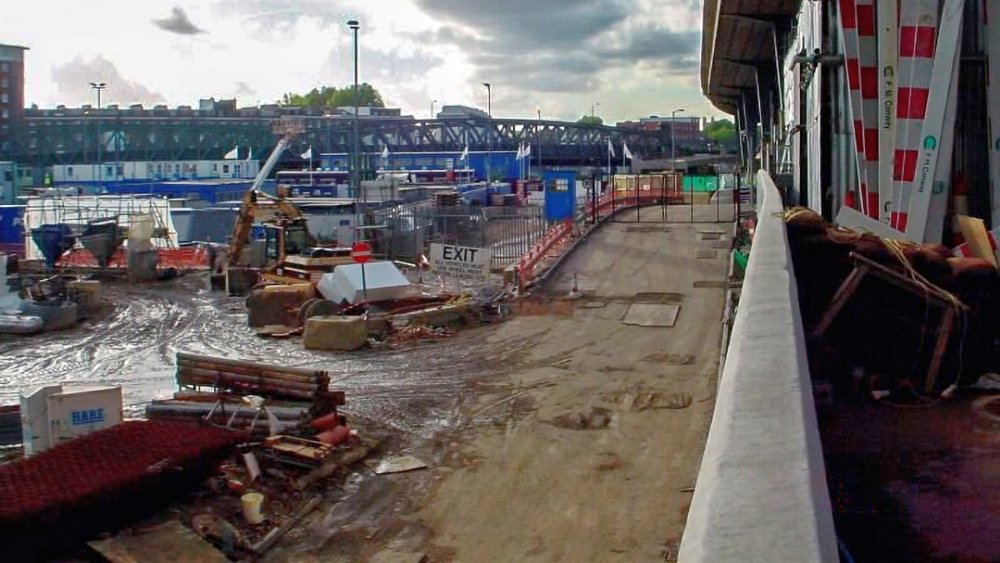
The area’s new development had barely begun when this view looking across the former Paddington Goods Depot site. The Battleship building is out of sight at right and the new road seen here coming in from the right is approximately where the former route to the goods yard was once. The elevated Westway can be seen above. The bridges seen in the background cross the Great Western main line on its approach to Paddington station. October 2001 photo by the author.
When the Paddington goods yard was in operation the Battleship building was the modern new means of accessing the depot. The new road layout meant that traffic coming off or onto the A40 could negotiate the various slip roads in order to reach the building’s gatehouse. The security gates were adorned with large British Rail logos. Having checked in, traders or rail staff could then drive their way down to the goods depot, or if needed, drive their vehicles to the Rotunda instead for maintenance or repair. The gatehouse was demolished sometime in the late 1980s.

The huge Paddington goods depot being demolished in 1986. Part of the Battleship building can be seen at right. Jack’s Books/Local History. (For a modern day perspective see Google Streets).
The buildings were refurbished in 2000-2002 when Monsoon took over residency. This was in line with the overall Paddington development that was taking place at the time – including the former goods yard and the large canal basin area. Virgin took over the Battleship building in April 2013 and had vacated the premises by December 2022 (this info is from documents held at Companies House). It was also where Branson’s personal offices in the UK were located. Interestingly Virgin Trains (both its West Coast and East Coast operations) were for a time based at the Battleship building. The loss of Virgin’s rail franchises no doubt took a toll and COVID didn’t help either. Had it not been for these circumstances I think Virgin would still have been at the Battleship building.
Battleship freehold for sale brochure from Pilcher London.
The Battleship buildings – a photo gallery by the author
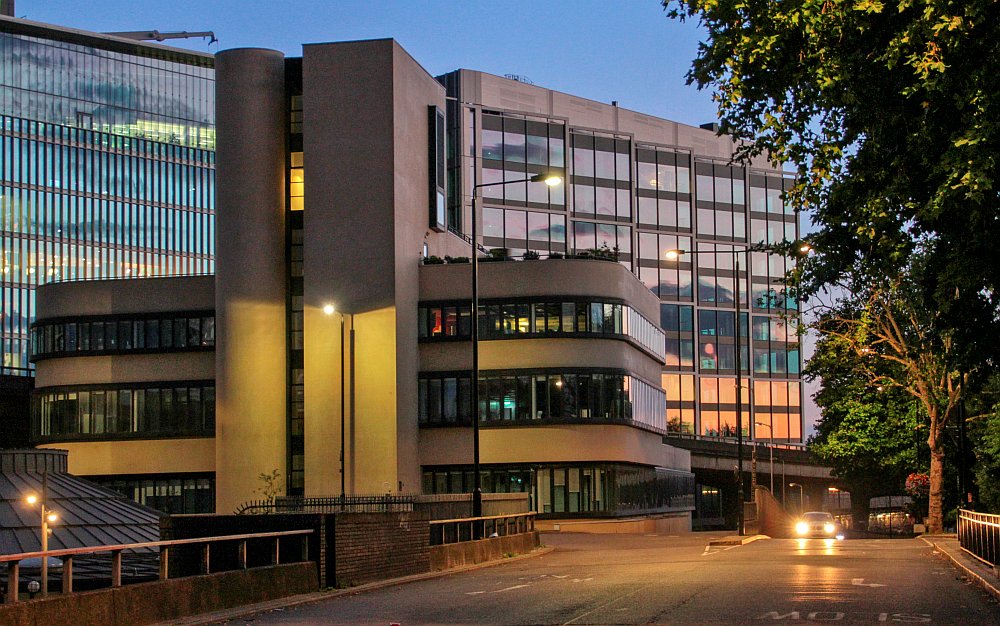
A colourful setting for the Battleship building! Photo taken August 2017.
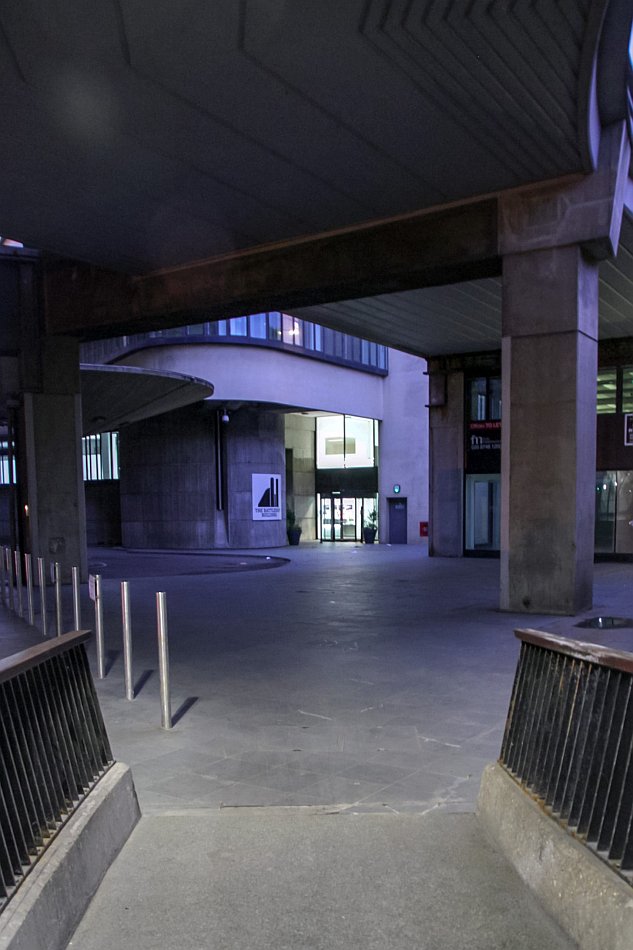
The walking route (‘pedestrian’ being an apt word here!) from Paddington to the Battleship building. August 2017.

The main entrance to the premises when Virgin were in residence. Notice the older Battleship building logo. August 2017.
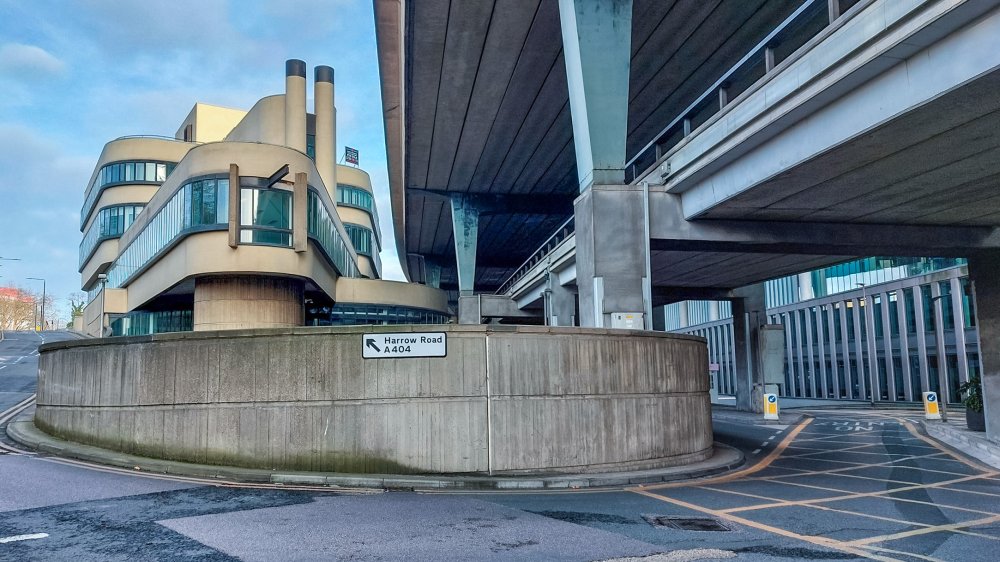
The rear (or is it the front?) of the premises. Its from this lesser known angle that the building’s ship like appearance becomes obvious. February 2025.
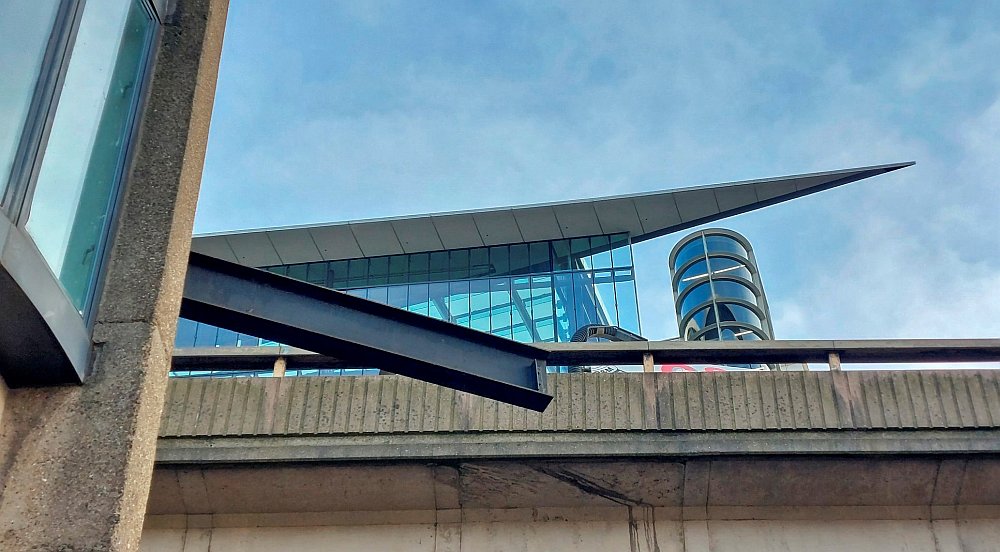
The western end of the building is said to represent a ship’s prow (or bows). Even the recent development at Paddington Central next door has followed suit with one of its buildings having a ship’s prow too! February 2025.
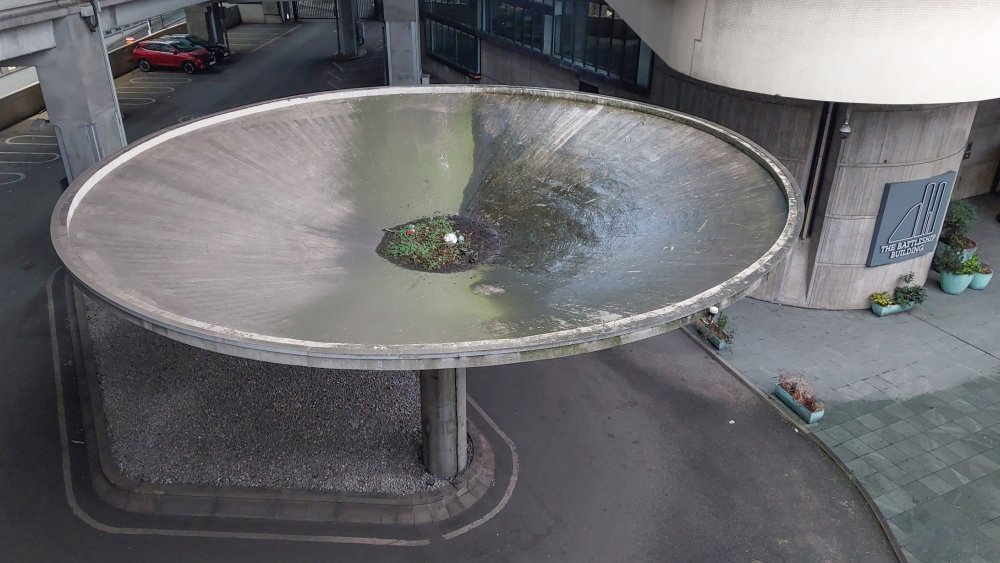
This odd looking umbrella structure as seen from the Westway gyratory road was once a servicing point for British Railway’s vehicle fleet. It was in fact the roof for a steam washing facility where vehicles could be given a quick clean in between journeys. Note the newer Battleship building logo. February 2025.
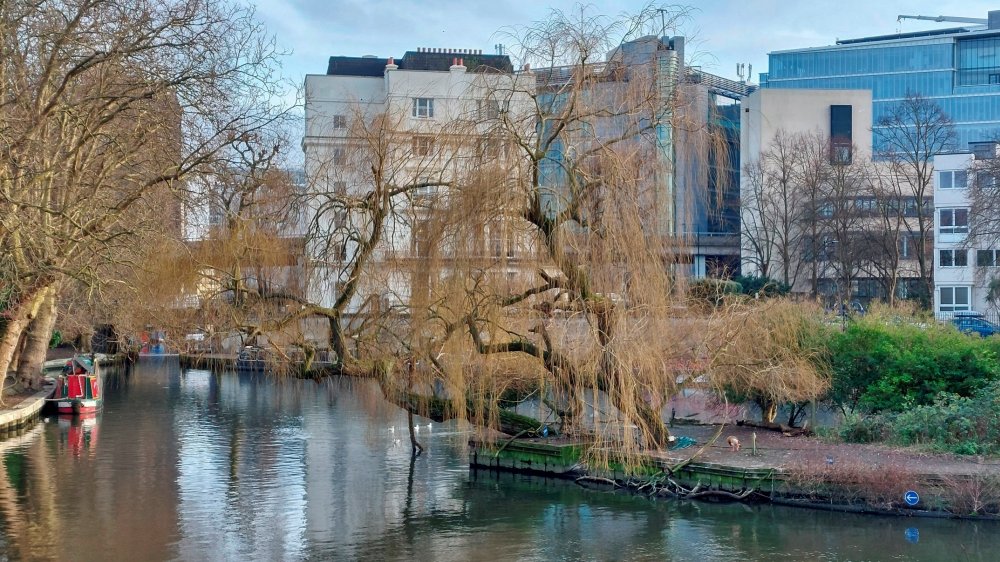
The Battleship building is no doubt immediately adjacent to the Little Venice/Paddington canals. This unique location gives rise to the notion the building represents a ship that’s been landlocked. This view of the building itself (at right) from Little Venice can only be seen in the winter however due to the trees. February 2025.
